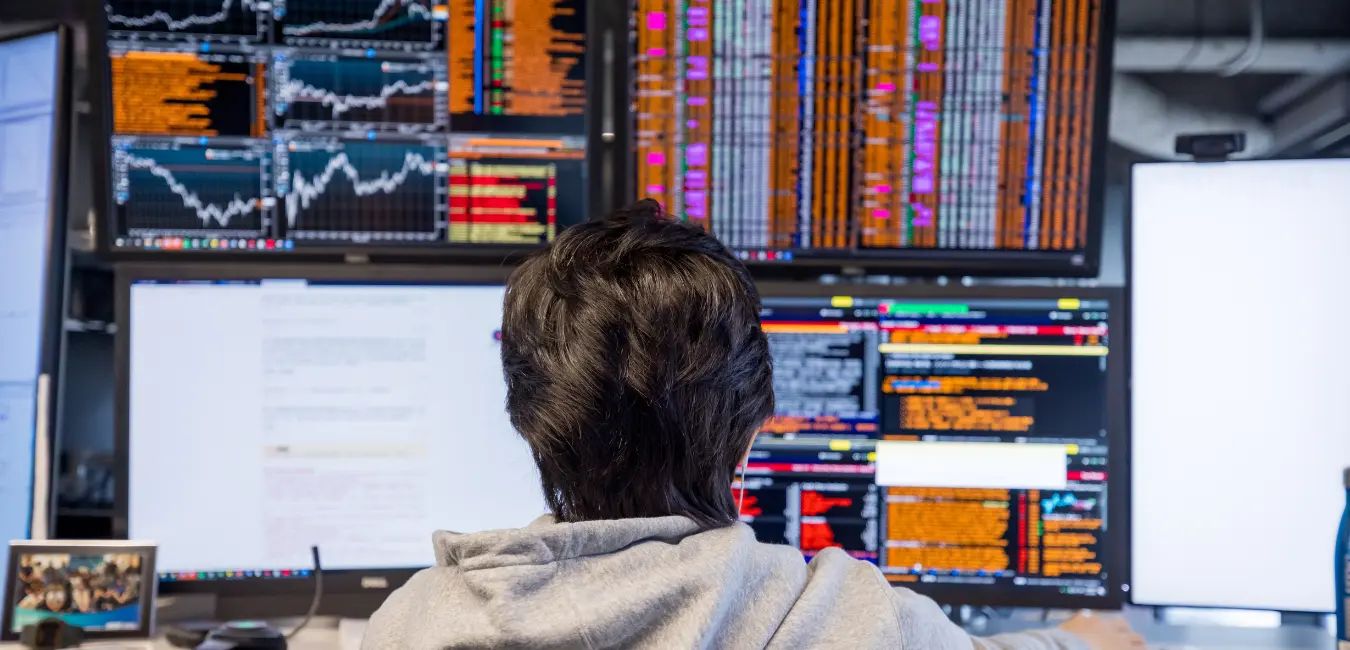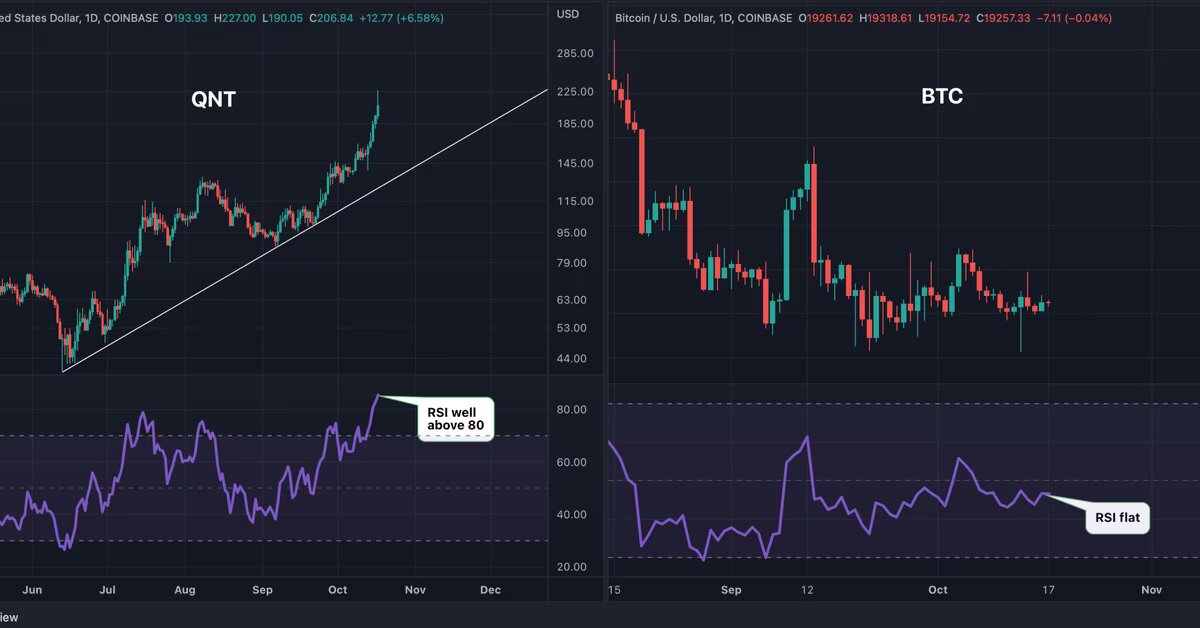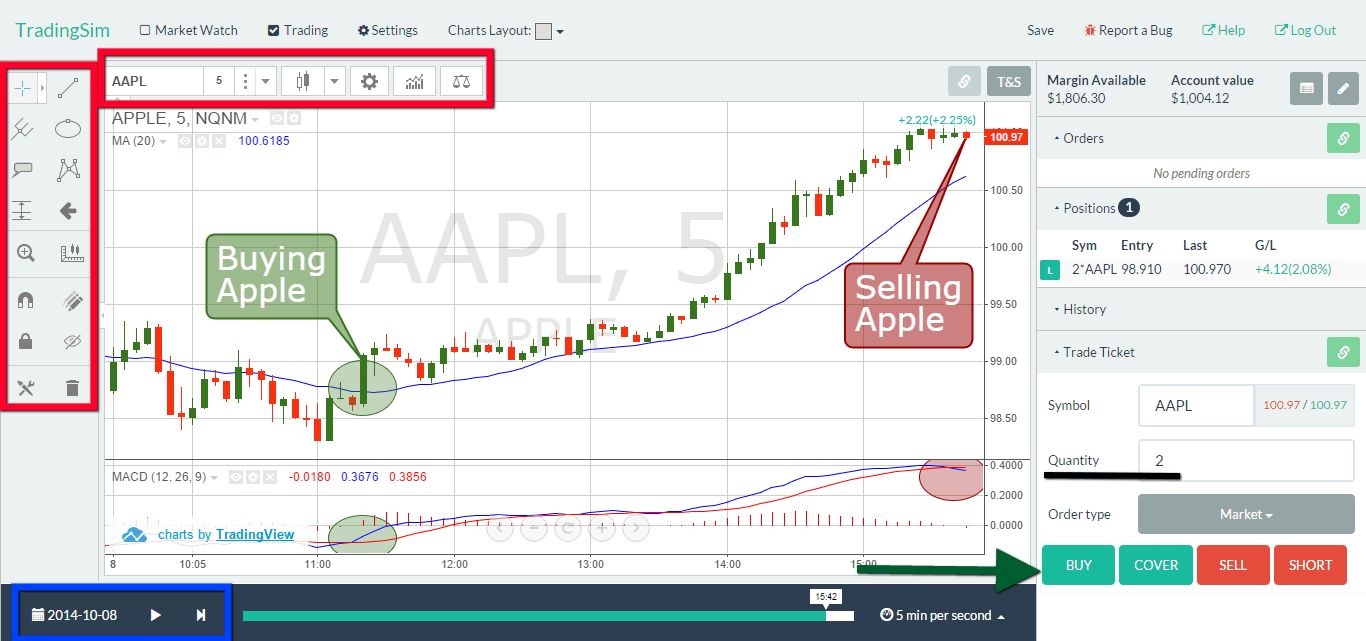Introduction
Welcome to the world of quant trading, where mathematics meets finance and cutting-edge technology drives investment strategies. If you’ve ever wondered how sophisticated algorithms and data analysis can be used to make profitable trades in the financial markets, then you’re in the right place. In this article, we’ll explore the fascinating field of quantitative trading, also known as quant trading, and delve into its inner workings, strategies, and potential benefits and challenges.
Quant trading is a discipline that combines mathematical models, statistical analysis, and computational power to identify and execute trading opportunities. It differs from traditional trading approaches, which rely on human intuition and subjective decision-making. Instead, quant trading relies on objective rules and mathematical formulas to analyze large volumes of data, identify patterns, and make informed trading decisions.
The rise of quant trading can be attributed to advancements in technology and the availability of vast amounts of financial data. With the advent of high-speed computers and sophisticated software, traders can now process vast amounts of information in real-time, enabling them to make quicker and more accurate trading decisions.
The goal of quant trading is to exploit market inefficiencies and generate consistent profits by taking advantage of short-term price movements or long-term trends. By relying on data-driven analysis rather than emotional or subjective judgments, quant traders aim to maximize returns while minimizing risks.
One of the key components of quant trading is the use of algorithms, which are sets of rules or instructions that guide the trading process. These algorithms are designed to analyze data, identify patterns, and execute trades automatically. They can be developed by traders themselves or purchased from specialized algorithmic trading firms.
In the following sections, we’ll explore the role of algorithms in quant trading and discuss some popular strategies employed by quant traders. We’ll also examine the benefits and risks associated with quant trading and provide some guidance on how to get started in this exciting field.
What is Quant Trading?
Quantitative trading, often referred to as quant trading, is a sophisticated approach to financial trading that combines advanced mathematical models, statistical analysis, and computer algorithms. It involves using quantitative methods to analyze vast amounts of financial data, identify patterns, and execute trades with the goal of generating consistent profits.
At its core, quant trading relies on the principle of using objective rules and data-driven analysis to make trading decisions, rather than relying on human emotions or subjective judgments. This approach helps remove biases and provides a systematic framework for trading, which can be more reliable and consistent in generating profits.
Quant trading encompasses a wide range of strategies and techniques, all geared towards leveraging the power of data analysis and computational models to gain an edge in the financial markets. These strategies can include statistical arbitrage, trend following, mean reversion, and machine learning-based approaches, among others.
One of the key advantages of quant trading is the ability to process and analyze large volumes of data quickly and efficiently. With the help of high-speed computers and advanced data processing algorithms, quant traders can sift through vast amounts of financial data, including historical price data, company financial statements, news releases, and economic indicators, to identify trading opportunities.
Quant trading often involves the development and utilization of complex mathematical models that incorporate various factors and variables, such as price movements, volume, volatility, and correlations. These models are calibrated and backtested using historical data to ensure their effectiveness in predicting future market movements.
Once the models are built and validated, computer algorithms are employed to automatically execute trades based on the signals generated by the models. These algorithms can take into account various factors, such as trading costs, risk management parameters, and market liquidity, to optimize the trade execution process.
It’s worth noting that quant trading is not limited to just equities. The principles and techniques used in quant trading can be applied to various financial instruments, including bonds, options, futures, and currencies. This flexibility allows quant traders to explore opportunities across different markets and asset classes.
In summary, quant trading is a data-driven, systematic approach to financial trading that leverages advanced mathematical models, statistical analysis, and computer algorithms. By removing emotional biases and relying on objective rules, quant traders aim to profit from market inefficiencies and generate consistent returns in a fast-paced and dynamic financial landscape.
How Does Quant Trading Work?
Quant trading relies on a combination of mathematical models, statistical analysis, and computer algorithms to identify trading opportunities and execute trades. Let’s take a closer look at how this process works:
Data Collection: The first step in quant trading is to collect relevant financial data. This can include historical price data, company financial statements, news articles, economic indicators, and any other information that can potentially impact the markets. The data is typically obtained from various sources, such as financial databases, market exchanges, and news feeds.
Data Preprocessing: Once the data is collected, it needs to be preprocessed to ensure its quality and suitability for analysis. This involves cleaning the data, handling missing values, removing outliers, and normalizing the data to make it consistent and comparable across different time periods and assets.
Model Development: Quant traders develop mathematical models that incorporate various factors and variables to analyze the data and generate trading signals. These models can range from simpler statistical models, such as moving averages and regression analysis, to more complex machine learning algorithms, such as neural networks and support vector machines. The models are calibrated and backtested using historical data to assess their performance and refine them if necessary.
Signal Generation: Once the models are developed and validated, they are used to generate trading signals. These signals indicate whether to buy, sell, or hold a particular asset based on the analysis of the data. The signals can be based on a variety of factors, including price movements, volume patterns, market volatility, and macroeconomic indicators.
Algorithmic Execution: In quant trading, computer algorithms are used to automatically execute trades based on the generated signals. These algorithms take into account various factors, such as trading costs, market liquidity, and risk management parameters, to optimize the trade execution process. The algorithms can be designed to place trades in real-time or at specific predefined intervals.
Monitoring and Optimization: Quant traders continuously monitor the performance of their trading strategies and make adjustments as needed. This involves analyzing the performance metrics, such as returns, drawdowns, and risk measures, to assess the effectiveness of the strategies. If necessary, the models and algorithms can be refined and adapted to changing market conditions.
Risk Management: Risk management is a crucial aspect of quant trading. Traders employ various techniques, such as position sizing, stop-loss orders, and portfolio diversification, to limit potential losses and manage overall portfolio risk. Risk management strategies are implemented to ensure that the potential gains outweigh the potential losses in the long run.
It’s important to note that quant trading is not a guaranteed path to profits. While quantitative models and algorithms can provide valuable insights and improve trading performance, they are subject to market risks and uncertainties. Human judgment, experience, and continuous monitoring are still essential elements in successful quant trading.
In summary, quant trading works by collecting and preprocessing financial data, developing mathematical models, generating trading signals, executing trades using algorithms, monitoring performance, and implementing risk management strategies. By leveraging data analysis and automation, quant traders aim to gain a competitive edge and capitalize on trading opportunities in the financial markets.
The Role of Algorithms in Quant Trading
In quantitative trading, algorithms play a pivotal role in the entire trading process. Algorithms, also known as trading bots or trading robots, are sets of rules and instructions that guide the trading decisions and execution. Let’s explore the various roles that algorithms play in quant trading:
Automated Trading: One of the primary functions of algorithms in quant trading is to automate the execution of trades. These algorithms are designed to receive trading signals from the quantitative models and execute trades without any manual intervention. Automation ensures that trades are executed quickly and efficiently, reducing the risk of delays or missed opportunities.
Speed and Efficiency: Algorithms facilitate high-speed trading, allowing quant traders to take advantage of even the smallest market inefficiencies. By leveraging advanced computer technology and low-latency connections to the exchanges, algorithms can execute trades within milliseconds, enabling quant traders to act swiftly and capitalize on price discrepancies.
Trade Execution Strategies: Algorithms can implement a variety of trade execution strategies, such as market orders, limit orders, and time-weighted average price (TWAP) orders. These strategies help optimize the trade execution process and minimize the impact of market fluctuations and slippage on transaction costs.
Risk Management: Algorithms play a crucial role in risk management within quant trading. They can incorporate risk criteria, such as maximum position size, stop-loss levels, and trailing stops, to automatically manage and control the downside risk. By adhering to predefined risk management rules, algorithms help protect the trading portfolio from substantial losses.
Dynamic Adjustments: Algorithms can dynamically adjust trading positions and strategies based on changing market conditions. For example, if volatility increases or specific market indicators reach certain thresholds, algorithms can automatically adjust position sizes, tighten stop-loss levels, or switch to alternative trading strategies. This adaptability helps quant traders respond to evolving market trends and minimize potential losses.
Backtesting and Optimization: Algorithms enable quant traders to backtest their trading strategies using historical data, allowing them to assess the performance and refine the strategies before deploying them in live trading. Through extensive backtesting and optimization, algorithms help traders identify the optimal parameter values and improve the overall effectiveness of their trading strategies.
Execution Cost Analysis: Algorithms can perform real-time analysis of execution costs, such as slippage and transaction fees, to assist in evaluating the profitability of trades. By considering the impact of execution costs, algorithms help quant traders assess the effectiveness of their trading strategies and make informed decisions on trade execution.
Overall, algorithms are the backbone of quantitative trading, enabling traders to automate the trading process, execute trades with precision and speed, manage risks, and adapt to changing market conditions. However, it’s important to remember that algorithms are tools to assist traders and should be used in conjunction with careful analysis, risk management techniques, and human judgment to achieve optimal trading results.
Popular Strategies in Quant Trading
Quantitative trading encompasses a wide range of strategies, each applying a unique approach to exploit market inefficiencies and generate profits. These strategies combine sophisticated mathematical models, statistical analysis, and computer algorithms to identify and execute trades. Here are some popular strategies commonly used in quant trading:
Statistical Arbitrage: Statistical arbitrage seeks to exploit pricing discrepancies between related securities. By analyzing historical data and statistical relationships, this strategy identifies pairs of securities that have historically exhibited a high correlation. When the prices of these securities deviate from their historical relationship, the strategy generates trades to capitalize on the expected convergence.
Trend Following: Trend following strategies aim to profit from the persistence of price trends. These strategies identify the direction of a market trend using technical indicators or statistical models and hold positions in the same direction as the trend. By riding the momentum, trend following strategies seek to capture significant gains during sustained price movements.
Mean Reversion: Mean reversion strategies assume that over time, prices will tend to revert to their mean or average value. These strategies identify securities that have deviated significantly from their historical mean and take positions opposite to the recent price movement, expecting a return to the average. Mean reversion strategies can be implemented in various time frames, from short-term intraday trading to longer-term swing trading.
Pairs Trading: Pairs trading involves identifying two highly correlated securities and taking simultaneous long and short positions in them. This strategy aims to capture the relative price movements between the two securities. If one security outperforms the other, profits can be made by taking a long position in the underperforming security and a short position in the outperforming security, anticipating a reversion to the mean relationship.
Machine Learning: Machine learning techniques, such as neural networks and support vector machines, are increasingly used in quant trading. These algorithms learn from historical data, identify patterns, and generate predictions or trading signals. Machine learning-based strategies can adapt to changing market conditions and incorporate complex non-linear relationships, allowing traders to capitalize on hidden patterns in the data.
Volatility Trading: Volatility trading strategies focus on capturing profits from changes in market volatility. These strategies involve taking positions based on expectations of future volatility levels or fluctuations. Volatility trading can be implemented through options trading, volatility index futures, or the use of volatility-derived indicators to time trades.
Market Making: Market making strategies involve providing liquidity to the market by placing limit orders around the current bid-ask spread. By continuously adjusting the bid and ask prices, market makers aim to profit from the spread between buying and selling prices. These strategies often require sophisticated algorithms to manage risk and handle order flow efficiently.
Event-Driven Trading: Event-driven strategies focus on taking advantage of price movements resulting from specific events, such as earnings releases, economic data announcements, or mergers and acquisitions. These strategies rely on analyzing the impact of the event on the relevant securities and taking positions before or after the event occurs.
These are just a few examples of the various strategies employed in quant trading. It’s important to note that each strategy carries its own unique risks, and successful implementation requires careful analysis, risk management, and continuous monitoring. Traders often combine multiple strategies or adapt existing strategies to suit their specific trading goals and preferences.
Benefits of Quant Trading
Quantitative trading offers several advantages that can attract both individual traders and institutional investors. Let’s explore some of the key benefits of quant trading:
Objective and Disciplined Approach: Quant trading removes emotional biases and subjective judgments from the trading process. By relying on data-driven analysis and systematic rules, quant traders can make consistent and objective decisions. This disciplined approach helps to eliminate behavioral biases, such as fear and greed, which can affect traditional traders.
Increased Speed and Efficiency: Quant traders utilize high-speed computers and algorithms to analyze data and execute trades within milliseconds. This speed and efficiency can provide a competitive advantage in capitalizing on market opportunities, especially in fast-moving and highly liquid markets.
Ability to Process Large Volumes of Data: Quant trading algorithms can handle enormous amounts of financial data and extract valuable insights from it. By analyzing historical price data, news releases, economic indicators, and other relevant information, quant traders can make informed trading decisions based on a comprehensive understanding of the market dynamics.
Diversification: Quant trading allows traders to diversify their portfolios across multiple markets, asset classes, and strategies. This diversification helps to spread risks and can potentially improve overall risk-adjusted returns. By simultaneously implementing multiple strategies, traders can optimize their risk-return profiles and reduce their exposure to individual market risks.
Backtesting and Optimization: Quant traders can conduct extensive backtesting of their trading strategies using historical data. This enables them to assess the performance of their strategies and refine them before deploying them in live trading. Through optimization, quant traders can fine-tune their models and algorithms to improve their effectiveness and adapt to changing market conditions.
Risk Management: Quant trading emphasizes robust risk management techniques. Traders can implement sophisticated algorithms to optimize position sizing, set stop-loss levels, and manage portfolio risk. By actively monitoring and managing risks, quant traders aim to limit potential losses and protect their trading capital.
Reduced Human Error: Quantitative trading minimizes the impact of human error often associated with manual trading. Algorithms execute trades precisely according to predefined rules, eliminating the potential for costly mistakes due to human judgment or execution errors.
Adaptability and Flexibility: Quantitative trading strategies can be designed to adapt to changing market conditions. Algorithms can automatically adjust position sizes, risk exposures, and trading strategies based on real-time market data and changing parameters. This adaptability allows traders to respond quickly to new information and market trends.
Potential for Consistent Returns: By leveraging systematic rules and data-driven analysis, quant trading aims to generate consistent and repeatable returns over time. While there are no guarantees of profitability, the ability to backtest and optimize strategies can increase the likelihood of achieving consistent performance over the long term.
It’s important to note that while quant trading offers various benefits, it also carries risks. Market uncertainties, model assumptions, and technical glitches can impact the profitability and performance of quantitative strategies. Successful quant traders employ risk management techniques and continuously monitor and refine their strategies to ensure long-term profitability.
Risks and Challenges in Quant Trading
While quant trading offers numerous benefits, it also comes with its fair share of risks and challenges. It’s essential for traders to be aware of these potential pitfalls and take necessary precautions. Let’s explore some of the key risks and challenges in quant trading:
Model Risk: Quantitative trading heavily relies on mathematical models and algorithms. However, these models are based on assumptions and historical data, and they may not accurately predict future market conditions. Model risk arises when the models fail to capture new market dynamics or when there are errors or biases in the model’s assumptions.
Data Quality and Reliability: The success of quant trading depends on the quality and reliability of the data used for analysis. Inaccurate or incomplete data can lead to flawed models and erroneous trading decisions. Traders must carefully vet and preprocess the data to ensure its accuracy and relevance.
Overfitting and Curve Fitting: Overfitting occurs when a model is excessively tuned to historical data and performs poorly on new, unseen data. Traders need to guard against overfitting by using robust validation techniques and avoiding excessively complex models that may be prone to curve fitting.
Market Risks: Quantitative trading is not immune to market risks. Market disruptions, extreme price movements, and unforeseen events can disrupt trading strategies and lead to significant losses. Traders must be mindful of the risks associated with the specific markets and instruments they trade and have mechanisms in place to respond to unexpected market conditions.
Technological Risks: The sophisticated technological infrastructure required for quant trading introduces its own set of risks. Connectivity issues, system failures, and cybersecurity threats can disrupt trading operations and compromise sensitive information. Traders must have reliable backup systems, robust security measures, and contingency plans to mitigate these technological risks.
Limited Historical Data: Historical data is crucial for building and backtesting quantitative models. However, markets and economic conditions evolve over time, and historical data may not fully capture the complexities of current market dynamics. Traders need to carefully consider the limitations of historical data and adjust their models and strategies accordingly.
Regulatory and Compliance Risks: Quant traders must navigate complex regulatory frameworks that govern financial markets. Compliance with regulatory requirements, such as licensing, reporting obligations, and risk management standards, poses challenges that traders need to address to operate legally and ethically.
Human Intervention and Decision-making: While quant trading aims to minimize emotional biases and human errors, human intervention is still necessary for monitoring and adjusting trading strategies. The challenge lies in striking the right balance between automated algorithms and human judgment, as too much or too little intervention can impact trading performance.
Capital and Liquidity Constraints: Scaling up quant trading strategies requires sufficient capital and access to liquid markets. Limited capital or illiquid markets can hinder the implementation of strategies with large position sizes or high-frequency trading approaches. Traders must carefully manage capital allocation and consider liquidity risks when designing their trading strategies.
Continuous Learning and Adaptation: The financial markets are dynamic and constantly evolving. Successful quant traders need to engage in continuous learning, stay updated with new research and techniques, and adapt their strategies to changing market conditions. Failure to adapt to new market trends or technological advancements can result in obsolescence and decreased profitability.
Quant trading presents substantial opportunities, but it also involves inherent risks and challenges. Traders should approach quant trading with caution, conduct thorough research, employ robust risk management practices, and continuously monitor and adapt their strategies to navigate these risks and challenges successfully.
Getting Started with Quant Trading
If you’re interested in diving into the world of quant trading, here are some key steps to help you get started:
Educate Yourself: Begin by educating yourself about quantitative trading concepts, strategies, and relevant technologies. Familiarize yourself with mathematical and statistical tools, programming languages such as Python or R, and concepts related to data analysis and algorithmic trading. There are numerous online courses, books, and resources available to help you build a solid foundation in quant trading.
Define Your Trading Strategy: Determine the type of trading strategy that aligns with your skills, interests, and risk tolerance. Consider factors such as the market you want to trade in, your preferred time frame, and the level of complexity you’re comfortable with. Define your trading goals, risk parameters, and rules for entering and exiting trades.
Acquire or Develop Quantitative Models: Depending on your preferences and abilities, you can either acquire pre-existing quantitative models or build your own. If you choose the latter, you’ll need to gather data, develop mathematical models, and create algorithms to execute trades based on your strategy. Backtest and validate your models using historical data to assess their performance and make necessary adjustments.
Utilize Technology and Tools: Make use of technology and tools to aid your quant trading journey. This includes computer software or platforms that facilitate data analysis, algorithm development, and backtesting. You can also explore dedicated algorithmic trading platforms that offer pre-built strategies, data feeds, and order execution capabilities.
Open a Trading Account: Once you have your strategy and technology in place, open a trading account with a brokerage firm that supports algorithmic trading. Ensure that the brokerage offers the necessary tools, APIs, and connectivity options to interface with your trading software. Consider factors such as commissions, execution speed, and customer support when choosing a brokerage.
Start with Simulated Trading: Before committing real capital, practice your strategies through simulated or paper trading. This will allow you to test your models and algorithms in a realistic trading environment without risking actual money. Evaluate the performance, adjust parameters as necessary, and gain confidence in your trading approach.
Risk Management and Capital Allocation: Develop a comprehensive risk management plan to protect your capital. Determine appropriate position sizes, set stop-loss levels, diversify your portfolio, and establish risk management rules based on your risk tolerance and financial goals. Ensure that you have sufficient capital reserved for trading and manage your position sizes accordingly.
Constant Monitoring and Adaptation: Continuously monitor the performance of your trading strategies and adjust them if necessary. Keep track of market conditions, news, and economic events that may impact your trading positions. Stay informed about the latest advancements in quantitative trading techniques and be willing to adapt your strategies as needed.
Learn from Others: Engage with the quant trading community, participate in forums, join online communities, attend conferences, and network with experienced quant traders. Learning from others can provide valuable insights, alternative perspectives, and new research that can enhance your trading approach.
Remember, quant trading requires a combination of quantitative skills, market knowledge, and perseverance. It’s crucial to continuously learn, refine your strategies, manage risks, and stay disciplined. With dedication, practice, and ongoing learning, you can embark on a successful journey in the exciting field of quant trading.
Conclusion
Quantitative trading, with its focus on data analysis, mathematical models, and algorithmic execution, has revolutionized the financial markets. It offers a systematic approach to trading that aims to remove human biases and emotions, improve efficiency, and generate consistent profits. While there are risks and challenges involved, the benefits of quant trading make it an attractive option for both individual traders and institutional investors.
By leveraging advanced technology and mathematical models, quant traders can process vast amounts of data, identify patterns, and execute trades with speed and precision. The use of algorithms enables automated and objective decision-making, ensuring consistency and discipline in the trading process. Additionally, backtesting and optimization allow traders to refine their strategies and assess their performance before deploying them in live trading.
Quant trading offers benefits such as increased efficiency, diversification, and risk management. It provides opportunities to capitalize on market inefficiencies, adapt to changing market conditions, and potentially achieve consistent returns. However, it’s important to be aware of the risks associated with model assumptions, data quality, market dynamics, regulatory constraints, and technological challenges.
To get started in quant trading, one must acquire knowledge, define a trading strategy, develop or acquire quantitative models, utilize technology and trading tools, open a trading account, and practice through simulated trading. Additionally, effective risk management, continuous monitoring, and ongoing learning are vital for success in this field.
Quant trading is an evolving field that requires traders to stay vigilant, adapt to market changes, and continuously improve their strategies. By combining quantitative skills, market knowledge, and risk management techniques, traders can navigate the challenges and potentially reap the rewards of this exciting and dynamic approach to trading.

























